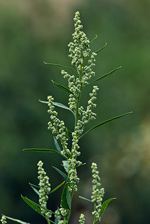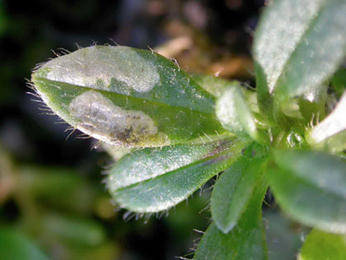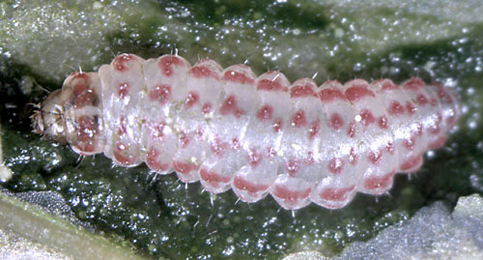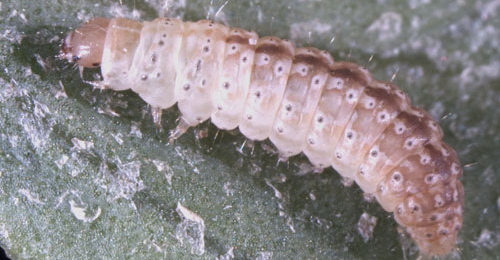|
||||||
|
CHENOPODIUM. Fat-hen, Good-King-Henry and Goosefoots. [Chenopodiaceae] |
|
|
Fifty species of Chenopodium are recorded in Britain. These include the native Fat-hen (C. album), Fig-leaved Goosefoot (C. ficifolium), Many-seeded Goosefoot (C. polyspermum), Maple-leaved Goosefoot (C. hybridum), Nettle-leaved Goosefoot (C. murale), Red Goosefoot (C. rubrum), Saltmarsh Goosefoot (C. chenopodioides), Stinking Goosefoot (C. vulvaria) and Upright Goosefoot (C. urbicum). The BSBI provide a downloadable plant cribs for the identification of species of Chenopodium. Stinking Goosefoot (C. vulvaria) is protected under Schedule 8 of the Wildlife and Countryside Act, 1981. Eighteen British miners are recorded on Chenopodium. Although previously recorded as a miner in stems of Chenopodium, Botanophila fugax is a common saprophagous species, the larvae normally feeding in the soil (G.C.D. Griffiths, pers. comm.). The coleophorid Coleophora saxicolella is recorded as a seed-feeder on Chenopodium in Britain. A key to the European miners recorded on Chenopodium is provided in Bladmineerders van Europa. |
 Fat-hen Chenopodium album |
Key for the identification of the known mines of British |
Note: Diptera larvae may live in a corridor mine, a corridor-blotch mine, or a blotch mine, but never in a case, a rolled or folded leaf, a tentiform mine or sandwiched between two more or less circular leaf sections in later instars. Pupation never in a cocoon. All mining Diptera larvae are leg-less maggots without a head capsule (see examples). They never have thoracic or abdominal legs. They do not have chewing mouthparts, although they do have a characteristic cephalo-pharyngeal skeleton (see examples), usually visible internally through the body wall. The larvae lie on their sides within the mine and use their pick-like mouthparts to feed on plant tissue. In some corridor miners frass may lie in two rows on alternate sides of the mine. In order to vacate the mine the fully grown larva cuts an exit slit, which is usually semi-circular (see Liriomyza huidobrensis video). The pupa is formed within the hardened last larval skin or puparium and as a result sheaths enclosing head appendages, wings and legs are not visible externally (see examples). See Key to non-Diptera. |
1# > Leaf-miner: Not distinguishable from the mines of P. betae or P. hyoscyami. |
|
Pegomya interruptella (Zetterstedt, 1855) [Diptera: Anthomyiidae]. |
1a > Leaf and stem miner: Eggs are scattered individually over the leaf upper surface; they are only loosely attached to the plant. The egg shell has a honeycomb structure. The larva begins with first mining one of the top leaves completely out. Next the larva moves down to another leaf, by way of a tunnel made in the stem. In this way several leaves are mined out, completely and full depth. In the attacked part of the plant the stem has become translucent; the damage causes the plant tip to wilt. In the first mines almost no frass is to be found, further down it is deposited in coarse grains. Pupation generally outside the mine (Miles, 1953). |
|
Delia echinata (Seguy, 1923) [Diptera: Anthomyiidae]. |
1b> Leaf-miner: Oviposition can take place in the leaf, where a short mine is formed. The young larva feeds towards the mid-rib and down into the stem. Alternatively a true mine can be formed in the stem before the larva burrows deeper into the pith. Pupation external (Spencer, 1976: 160). The larva bores in the pith of the stem, and eats this out while descending as low as the root collar. But before that it makes a linear mine in the green rind of the stem. Occasionally oviposition takes place on a leaf, leading to a fine corridor (without frass) running towards the midrib, and from there to the stem. The place where the larva finally exits the stem for pupation is indicated by a red-ringed hole. Puparium yellow |
|
Amauromyza chenopodivora Spencer, 1975 [Diptera: Agromyzidae]. |
1c > Leaf-miner: A white linear-blotch mine, the linear section sometimes not detectable as it becomes enveloped in later blotch (Spencer, 1976: 162-3, figs 296-7). Upper-surface, less often lower-surface, corridor, followed, and often overrun, by a large blotch. Even when the corridor is overun, it usually remains recognisable in the frass pattern. The mine looks whitish in the field. The blotch does not contain much frass, in the form of small black grains, dispersed and stuck to the floor of the mine. Feeding punctures upper-surface (always?). Pupation outside the mine. A common miner, forming a white linear blotch mine (the blotch may obscure the linear portion of the mine) in both native and garden plants. |
|
Amauromyza flavifrons (Meigen, 1830) [Diptera: Agromyzidae]. |
1d > Leaf-miner: Large blotch mine, often with several larvae, beginning with a short deeper corridor at a single egg shell on the surface of the leaf. The broad deep corridor later ends in a blotch but can be recognised (beneath the blotch) by its greater depth. Mine predominantly dorsal or ventral, greenish in transmitted light. Frass grains irregularly scattered except in the initial corridor. Blotch, mostly occupying almos the entire leaf, containing several larvae. Much, half-deliquescent, greenish-black frass. At the start of the mine at the leaf underside a group of some 5 elliptic egg shells, parallel to each other. However, the larvae can leave their mine and restart elsewhere, so mines without egg shells can occur as well. The larvae do not penetrate into the stem of the plant, neither is the mine full depth (compare Delia species). Mine indistinguishable from P. exilis or P. hyoscyami. Makes a large upper surface whitish blotch, which can contain several larvae. The frass has a washed out appearance and is greenish. There may be several mines on a leaf and eventually the leaf will be mined and then shrivel up. To identify this miner adults must be reared. |
|
Pegomya hyoscyami (Panzer, 1809) [Diptera: Anthomyiidae]. |
1e > Leaf-miner: Mine indistinguishable from that of P. hyoscyami. A large blotch mine, often with several larvae, beginning with a short deeper corridor at a single egg shell on the surface of the leaf. The broad deep corridor later ends in a blotch but can be recognised (beneath the blotch) by its greater depth. Mine predominantly dorsal or ventral, greenish in transmitted light. Frass grains irregularly scattered except in the initial corridor. |
|
Pegomya conformis (Fallén, 1825) [Diptera: Anthomyiidae]. |
1f > Leaf-mine: Mine indistinguishable from P. betae or P. hyoscyami. |
|
Pegomya exilis (Meigen, 1826) [Diptera: Anthomyiidae] |
1g > Leaf-miner: The larva makes several full depth blotch mines. |
|
Pegomya cunicularia (Rondani, 1866) [Diptera: Anthomyiidae]. |
1h > Leaf-miner: Blotch mines, generally occupying an entire leaf, usually containing several larvae. Much, half deliquescent, green frass. Mine indistinguishable from P. exilis or P. hyoscyami. |
|
Pegomya betae (Curtis, 1847) [Diptera: Anthomyiidae]. |
1i > Leaf-miner: Mine linear, whitish, both upper and lower surface. Pupation internal, at the end of the mine with the anterior spiracles projecting through the epidermis (Spencer, 1976: 433). Upper-surface, less often lower-surface corridor. Frass in isolated grains. Pupation within the mine, usually in a lower-surface puparial chamber. A long whitish upper surface corridor, which eventually goes lower surface. |
|
Chromatomyia horticola (Goureau, 1851) [Diptera: Agromyzidae]. |
1j > Leaf-miner: A short, irregular, linear upper surface mine on any part of the leaf. Also recorded from young pods (Bland, 1997a). Long corridor mine. As a rule the first part of the mine is lower-surface, the later part upper-surface. Often the loops are so dense that a secondary blotch is the result. Because upper- and lower-surface corridor segments often cross, the mine obtains a strange array of transparant patches. There is no association with the midrib. Frass in strings and thread fragments. Pupation outside the mine; exit slit in upper epidermis. Mine not associated with the veins or midrib of the leaf (It is this character which enables distinction from another Agromyzid pest species - Liriomyza huidobriensis). The larvae may leave one leaf (if not large enough) and enter another leaf, via the petiole). It exits the leaf to pupate through a semi-circular slit in the upper surface of the leaf. |
|
Liriomyza bryoniae (Kaltenbach, 1858) [Diptera: Agromyzidae]. |
1k > Leaf-miner: The mine starts as a long, narrow, winding corridor running towards the midrib, widening to a blotch. Usually upper-surface, but in small leaves also full-depth parts may occur. The blotch has broad lobes; in their ends most frass is accumulated in the form of green patches or clouds. Sometimes several larvae share mine. Pupation usually in the soil, less often in the leaf (and then generally not in the mine itself but in a small separated mine, that may even be made in the petiole). |
 Mine of Scaptomyza graminum on Cerastium glomeratum Image: © Jean-Yves Baugnée (Bladmineerders van Europa) |
|
Scaptomyza graminum (Fallén, 1823) [Diptera: Drosophilidae]. |
|
Key for the identification of the known mines of British |
Note: The larvae of mining Coleoptera, Hymenoptera and Lepidoptera may live in a corridor mine, a corridor-blotch mine, a blotch mine, a case, a rolled or folded leaf, a tentiform mine or sandwiched between two more or less circular leaf sections in later instars. Larva may pupate in a silk cocoon. The larva may have six legs (although they may be reduced or absent), a head capsule and chewing mouthparts with opposable mandibles (see video of a gracillarid larva feeding). Larvae of Hymenoptera and Lepidoptera usually also have abdominal legs (see examples). Frass, if present, never in two rows. Unless feeding externally from within a case the larva usually vacates the mine by chewing an exit hole. Pupa with visible head appendages, wings and legs which lie in sheaths (see examples). |
1a > Leaf-miner: Initially a gallery is formed, this turning into a blotch, and later two successive conical leaf-rolls. Initially a pale, later brown, usually lower-surface blotch. The blotch is preceded by an epidermal corridor, but that may be obliterated by the later blotch. Silk at the inside of the mine causes it to buckle up a bit and fold. The reddish brown frass is accumulated in a corner of the mine. The older larva leaves the mine and continues feeding inside an untidy cone, made by cutting off a strip of leaf tissue and stitching it in place with silk. |
|
Calybites phasianipennella (Hübner, 1813) [Lepidoptera: Gracillariidae]. |
1b > Leaf-miner: The red and white larvae feed by mining the leaves forming a contorted gallery. A strongly contorted, often intestinine-like corridor, often forming a secondary blotch. Much green frass in broad arcs. Full grown larva mostly on top of the midrib. Pupation external. |
 Chrysoesthia drurella larva, dorsal Image: © Willem Ellis (Bladmineerders van Europa) |
|
Chrysoesthia drurella (Fabricius, 1775) [Lepidoptera: Gelechiidae]. |
1c > Leaf-miner: Whitish blotches in the leaves. The mine begins as a short zigzagging corridor, that very soon becomes overrun by a large, perfectly transparent blotch. Frass in a big black central lump. In fresh mines something like primary feeding lines are recognisable, normally seen only in Diptera mines. Pupation external, exit a rather untidy hole. A large, whitish blotch sometimes occupying most or all of the leaf. The frass is mostly ejected from the mine.. |
|
Chrysoesthia sexguttella (Thunberg, 1794) [Lepidoptera: Gelechiidae]. |
1d > Leaf-miner: In the first instar the larva mines the leaves, forming short, irregular, blotch-like mines, but in later instars it lives externally, feeding in spun leaves and often twisting those of tender shoots. Larval head light-brown or yellowish brown, edged with black postero-laterally, ocellar area blackish; prothoracic plate black edged with whitish anteriorly; abdomen dull dark green; pinacula distinct, black, sometimes brownish but with black bases to setae; anal plate large, black (Bradley et al., 1973). Small, full depth mine without a definite shape; little frass. Some silk is deposited in the mine. The larva soon leaves the mine and continues feeding among spun leaves. |
|
Cnephasia incertana (Treitschke, 1835) [Lepidoptera: Tortricidae]. |
1e > Leaf-miner: Young larvae make irregular corridor-like or blotch-like mines from a silken tube. The mines contain almost no frass. |
|
Scrobipalpa atriplicella (Fischer von Röslerstamm, 1841) [Lepidoptera: Gelechiidae]. |
1f > Leaf-miner: The first instar larva tends to make a U-shaped mine, whereas later larvae make irregular mines. Final instar larvae spin the leaves together and feed in a silken tube amongst the seeds. Young larvae make a short, spiralled corridor typically U-shaped). This stage is followed by an irregular, sometimes branching, greenish-white blotch. In their final stage the larva lives free in a silken tunnel among the leaves. Pupation in a cocoon of sand grains and detritus. |
 Scrobipalpa nitentella larva, dorsal Image: © Willem Ellis (Bladmineerders van Europa) |
|
| Scrobipalpa nitentella (Fuchs, 1902) [Lepidoptera: Gelechiidae]. |
| Last updated 02-Jul-2019 Brian Pitkin | ||
